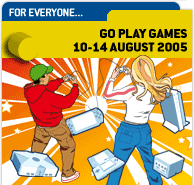Edinburgh essays - I need a hero
Contestants will be tasked at Edinburgh Interactive Entertainment Festival with creating a new game hero. Can they create one to beat Lara? Can anyone? Eidos Creative Director, Ian Livingstone, gives his vision of the future of interactive heroes. Interview: Simon Munk"During the 8-bit and16-bit era, games were mainly targeted at children and young teenagers characters were cutesy and the games were two dimensional. When the PlayStation and the other 32-bit machines were launched, games were available in 3D with 3rd person characters. The gaming worlds were immediately more real and lifelike. And the children who had been playing games on their 16-bit machines hadnt stopped playing games they had just got older and naturally they wanted more mature content. So in hindsight it was not really a surprise what these young adults wanted to look at. A hedgehog, a plumber or Lara Crofts pert bottom!
"Being the right character at the right time was one of the reasons why Lara was so successful. Also she was one of the first games published with a 3rd person character and was definitely the first female character. Core had made a bold move with the character but lets not forget that Tomb Raider was also a great game to play with great graphics and amazing technology for the time. Core had reinvented the action/adventure genre. But Lara herself was down to one visionary at Core - Toby Gard who designed her. Toby had observed by Neneh Cherry, Tank Girl and the rise of girl power at the time. He realised a strong, independent woman was attractive. So Lara was dynamic, beautiful, sexy, athletic things guys like. But also she was independent, strong, adventurous qualities attractive to women.
"Lara’s level of appeal is unique in modern games. Can you name any other gaming character who is as well known and has survived the test of time? Everybody knows Grand Theft Auto, but none of the characters in the game are household names. Time Digital did a survey a few years ago and Lara was more recognised than Pope John Paul II.
"Lara transcended games. She’s became a household name and a powerful brand. Because of that, people liked to think that they knew her. Even though she is a virtual character she became almost human. Maybe Angelina Jolie helped in that respect! As a game heroine, the desire of her fans to want to know more about Lara coupled with the imminent launch of new console platforms today creates a new set of challenges to keep her as popular and strong in the future as she has been in the past.
"You have to invest and innovate or the franchise will suffer. The last iteration of Tomb Raider did not live up to customers expectations. The control and the content were simply not good enough. That was one of the reasons why the development of Tomb Raider:Legend was moved from Core to Crystal Dynamics. Fresh minds and a fresh approach based on market information was needed. Crystal Dynamics was also acknowledged for its superb technology. And bringing back Toby Gard was a huge bonus. We have every intention of fulfilling fans expectations and are very confident we will do so.
How do you innovate with such a well-known character? In a way, the advantage is people already know her so well. Everybody still loves Lara. And we want them to get to know her even more. What makes her tick? What about her emotions? We want people to know everything about her. And we want to portray her in games as if she is a real person by increased use of narrative and dialogue.
"With the next generation of consoles, games will become more of an art form and emotion will be a strong feature of game characters. We will see them cry, laugh, be frightened, etc. and, therefore, there will be even more emotional attachment to them. Using the talent and expertise of the film industry by hiring scriptwriters, storytellers, actors, lighting engineers, etc, the challenge now is for games companies to make dramatic, emotion-filled games that are essentially interactive movies.
"Remember this industry has only been around for 30 years or so. In the late 70s games like Pong were a single pixel moving back and forth across a black and white screen. 15 years ago they were two-dimensional stick men. Now we can create and animate virtual real people who live in glorious 3D worlds.
Everybody is talking about convergence these days. There used to be a clear distinction between film and games companies. The media differed but now both films and games are being played on the same devices. There is convergence too in the creative talent and there is content convergence in that games are made of films and also films are made of games - none more successful than Tomb Raider.
"In this climate of increasing production costs there is an obvious need for companies to reduce their risk. There is good justification to use an already established hero - from a film, from a comic or from a book. That’s why games companies are looking more and more to Hollywood to get film characters on which to make games. And conversely this is why film companies are talking with games companies to find content. It costs more and it is riskier to launch new characters and IP. But new heroes will emerge.Whichever way games companies approach this, heroes will continue to be very important as the world of gaming expands through new devices and mass market acceptance. Heroes are, however, changing in the online space where the current craze is ‘customisation’. Like role-playing games of old, players are creating their own avatars. In these perpetual worlds, player alter-egos are the new heroes. In the games industry the mantra always used to be 'content is king'. Now ‘community is king’ as in the players are creating the content. And we as publishers and developers are creating the communities in which players can customise and play. Build it and they will come!
But not everyone wants to play online games and there will always be a big market for character-based games. Its just that the characters will need more character! And for those just coming into games, there’s no better way of introduction than by playing the role of a well-known character. Games companies know this. From James Bond to Lara Croft, the world still needs its heroes.


























